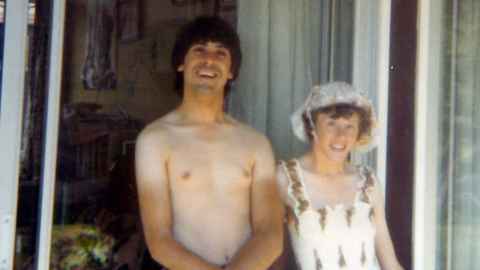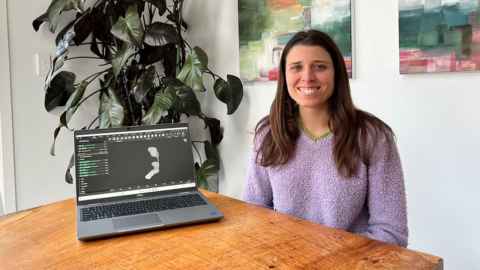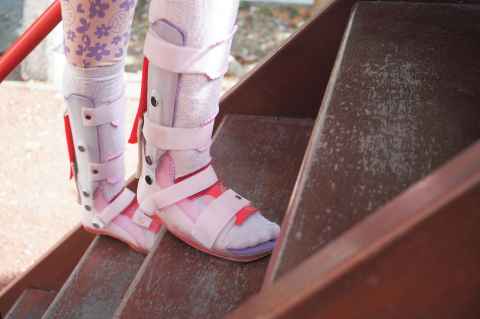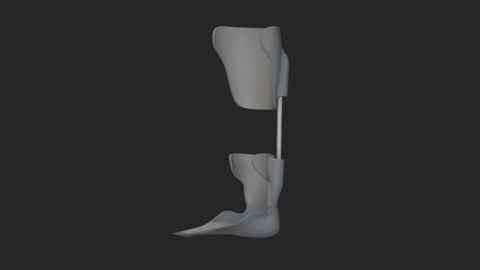ABI scholarship winner Ella Thomas to build on a legacy of love
24 September 2024
Julie and Carlo Fiorentino lived a remarkable life, despite having cerebral palsy. Their $1 million bequest to the Auckland Bioengineering Institute will help make children's leg braces cool – and that's just the beginning.

It was 1972 and Julie Thornley was a 19-year-old with a love of science, a wicked sense of humour, and a boyfriend called Carlo Fiorentino. She also had cerebral palsy (CP) – and a problem.
Her problem was that Carlo, who also had CP (and an equally wicked sense of humour), had been awarded one of the highly sought-after residential slots at the Laura Fergusson Trust facility in Auckland, where people with disabilities were supported to live as self-sufficient a life as possible.
But when Julie applied for a place, she was turned down; assessors said she wasn’t physically independent enough.
“Julie worked for three years to get enough muscle strength and coordination to be able to get herself up in the morning, to wash and dress, so she could live at Laura Fergusson and be with Carlo,” says her nephew, godson and executor Marcus Thornley. “They loved each other and they wanted to be together.”

In 1975, Julie finally got her place, but it had been a long and tough physical challenge. That same challenge – to find practical solutions to allow them to live active and independent lives in spite of their disability – was one which continued for both Julie and Carlo for the next 40 years.
And it led to them making an important decision before they died: to leave money in their will to advance research which helped make life easier for people with cerebral palsy.

Cerebral palsy is caused by damage to a child’s brain during pregnancy or when they are born. About 70 percent of cases result from a birth injury, and there's no cure.
People with cerebral palsy may have problems with, for example, movement, muscle coordination, posture, and balance. They may also have epilepsy, hearing or visual impairment, or an intellectual disability.
Around 10,000 people in New Zealand and 17 million globally have the condition.
Tough lives well lived
Carlo was born in Nelson in 1949, and Julie in Wellington in 1953. They first met at the Pukeroa Home for disabled young people in Hawke’s Bay, when Carlo was 18 and Julie was 14. But after that, it was hard for them to spend time together until Julie got into Laura Fergusson – when life changed.
They both found jobs, and in the late 1980s they had enough money to move into their own home. Despite a raft of physical challenges, which only got worse as they got older, they lived full lives, Marcus says, going on expeditions on their mobility scooters and with a raft of friends and support people helping them stay together and keep their independence.
“So many people loved Julie and Carlo,” Marcus says. “They lived a life different from other people, but still a life filled with love.
”As they got older, Marcus says the pair started wondering about what to do with their money when they died. They didn’t have children, and crazy house prices meant the small home they had bought 30 years before was now worth close to a million dollars – a sum they realised could make a significant difference.

Julie died in 2019, and in 2020 Carlo met with Professor Thor Besier, head of the musculoskeletal team at the Auckland Bioengineering Institute. Carlo recognised the potential for the work of Thor's team to impact the lives of people with cerebral palsy well into the future; when he died he gifted the couple’s entire estate to the university.
The terms of the bequest are that the money be invested ‘in perpetuity’, with the interest each year going to fund a postgraduate scholarship for research into practical solutions for movement disorders like cerebral palsy.

Ella Thomas is the first recipient of the Carlo and Julie Fiorentino Scholarship in Movement Disorder, and started her research project in March. But her background isn’t what you might expect for work in the Auckland Bioengineering Institute: she’s a product designer.
Her goal: to help design a supportive leg brace for children with cerebral palsy – one that they might just be happy (maybe even proud) to wear.
Specialist foot and leg braces (commonly called ‘orthotics’ in the trade) aren’t new: they’ve been used for decades to help stabilise and support the muscles and joints in the feet, ankles and legs of children with a range of movement disorders, making it easier for them to stand and walk.

Orthotics mostly work – if children wear them. But the traditional one-size-fits-all approach from medical specialists means there’s very little thought put into how a leg brace might look and feel to a seven or 10-year-old, Thor says. They are often ugly, painful – and unused.
Which is where Ella Thomas’ work comes in.
“From the literature, it seems children are often given this huge clunky thing and told to put it on,” she says. “It might be made of a solid plastic, so it’s sweaty and uncomfortable; it might be really big so they have to wear shoes two sizes too big, or they can’t wear the trousers they like. It might work for walking but they can’t run around with their friends.”
The goal is to create something that has the kids’ interest at heart and can be customised so they want to wear it; so it’s not shameful or too bulky. Why not colours, or unicorns?
So after the initial trial period, there’s a risk children refuse to wear their braces, or don’t wear them as much as they should to get maximum benefit, Ella says.
“There’s a correlation between biomechanics and form and aesthetics which has been completely overlooked in past studies – particularly for kids. Demographics and aesthetics play an enormous part in terms of compliance.”
Advances in 3D printing means personalising orthotics for a particular child is increasingly possible, so you can get a brace that works well, is comfortable, and might even be a little bit ‘cool’, Thor Besier says.
But so far, that’s not happened. Traditionally, people with cerebral palsy have been lumped together in terms of the orthotics that might work for them, he says. But CP is a disorder with a wide range of outcomes, and different children can need very different solutions.
While other members of the musculoskeletal team are working on customisable biomechanics for a personalised orthotic device, this year’s Fiorentino bequest funding for Ella’s work is critical to bring design into the mix, Ella says.
“The goal is to create something that has the kids’ interest at heart and can be customised so they want to wear it; so it’s not shameful or too bulky."
Why not colours, or unicorns?
The first step will be working on a modular design where clinicians – and their patients can play around with comfort and aesthetics. A first design iteration could be available to be 3D printed as early as this month, and children with cerebral palsy could be making choices in trials next year.

A marketable product might be possible in the next two to three years, Thor says. And with high-quality orthotics for individual children able to be printed in Aotearoa, there’s also the potential to significantly speed up the normally lengthy process for making, fitting and upgrading leg braces.
There are also plenty of opportunities for developing the idea further – potentially with future money from the Fiorentino bequest, Thor says.
“There are a whole lot of things we could do to improve compliance – for example, putting sensors into the orthosis to show clinicians how the kids are using them. Or you could game-ify them. A child could be playing on their phone and exercising their muscles at the same time.”
Independent disability advocate Jane Carrigan, who was a friend of Julie and Carlo and is an executor of their will, says the orthotics design project is exactly what the Fiorentinos would have wanted to see happening with their endowment funds.
“Carlo wore those sorts of braces, and I’m sure no one would be happier than him that this is the first project the money has gone towards.
“Julie was very science-oriented, and both of them were people who would have wanted to do something that could make people’s lives simpler. It’s absolutely the sort of thing that would have benefitted both of them back in the day.”
People don’t have to have a million dollars to leave in their will to have an impact, especially when it is to a University research project.
Nicole Bassett is development manager at the Auckland Bioengineering and Liggins Institutes. She says people don’t have to have a million dollars to leave in their will to have an impact, especially when it is to a University research project.
“If every person over 18 in New Zealand donated $1 to research then we would have over $3 million to make a difference. People can leave as little as 1 percent of their residual estate to research – that’s after you have taken care of whanau and donated to your favourite charity or charities.”
Marcus says it’s important to his and Julia’s family that the bequest can continue to support research into cerebral palsy far into the future.
“Their gift is not just a gift to science and engineering; it is a gift of love to people with movement disorders who will benefit from the work Auckland Bioengineering researchers will do now and in years to come.
“They will benefit from the love two people experienced in their lives.”
Media contact
Nikki Mandow | Research communications
M: 021 174 3142
E: nikki.mandow@auckland.ac.nz